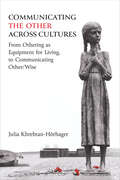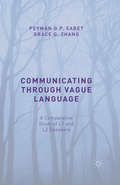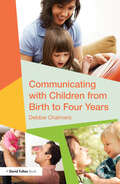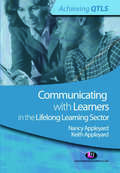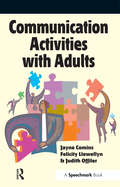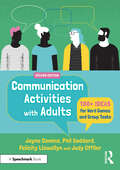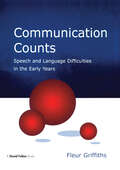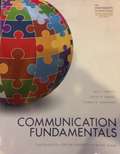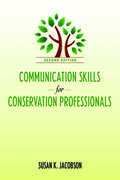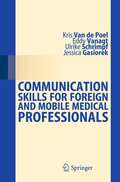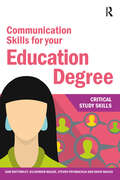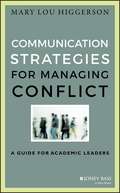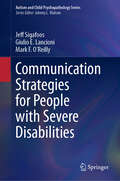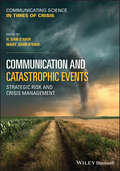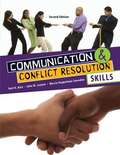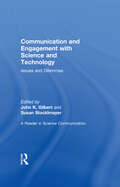- Table View
- List View
Communicating in Intercultural Spaces
by Lily A. Arasaratnam-Smith L. Ripley SmithCommunicating in Intercultural Spaces is a unique contribution to literature in intercultural communication from two authors who bring distinct socio-cultural voices to this work. Written for readers ranging from advanced undergraduate students to intercultural practitioners, this book offers a new conceptualisation for understanding intercultural communication. Eight propositions frame the concept of intercultural spaces.Grounding the discussion on the framing of intercultural spaces, the authors engage with a range of topics such as perception, language, acculturation, and intercultural competence, couched in original personal narratives from 21 leading intercultural scholars. The narratives and vignettes add vibrant context to the scholars’ works that are cited in this book. The book also delves into the origins of intercultural communication as a discipline and the dark side of communicating across differences. Each chapter ends with a brief dialogue between the authors, followed by questions for stimulating further reflection.Readers should expect to walk away with an understanding of key theories and frameworks in intercultural communication and the tools with which to develop their own intercultural communication competence.
Communicating the Other across Cultures: From Othering as Equipment for Living, to Communicating Other/Wise
by Julia Khrebtan-HörhagerWhenever political and social decisions use categories of identity such as race, religion, social class, or nationality to distinguish groups of people, they risk holding certain groups as inferior and culturally “Other.” When people employ ideologies of imperialism, colonialism, patriarchy, and classism, they position certain groups as superior or ideal/ized people. Such ideological positioning causes nations to take actions that isolate or endanger minoritized populations. This cultural Othering can lead to atrocities such as Native Americans being expelled from their native lands through the Trail of Tears, millions of Ukrainians starving to death during the Holodomor, or millions of Jews exterminated during the Holocaust. Communicating the Other across Cultures uses examples from the United States, Western Europe, and Russia to demonstrate historical patterns of Othering people, as well as how marginalized people fight back against dominant powers that seek to silence or erase them. Deeply ingrained in our society, cultural Othering affects information in history books, children’s education, and the values upheld in our society. By taking a closer look at historical and modern instances of Othering, Julia Khrebtan-Hörhager shows examples of how different societies created ideas of social and cultural superiority or inferiority, and how deeply they are ingrained in our current society. In everyday life—the cash in your pocket, the movies shown at your local theater, museum exhibits, or politician's speeches—certain cultural ideologies are consistently upheld, while others are silenced. By exposing the communicative patterns of those in power, Khrebtan-Hörhager then suggests alternative ways of thinking, communicating, and eventually being, that offer transformative solutions for global problems.
Communicating through Vague Language: A Comparative Study of L1 and L2 Speakers
by Grace Q. Zhang Peyman G.P. SabetThis book is a comparative study of vague language based on naturally occurring data of L1 and L2 speakers in academic settings. It explores how L2 learners have diverse and culturally specific needs for vague language compared with L1s, and are generally vaguer.
Communicating with Asia
by Gerhard LeitnerCommunicating with Asia brings together an international team of leading researchers to discuss South, South-East, East and Central Asia, and explore Mandarin, Cantonese, Hindi-Urdu, Malay, and Russian as major languages. The volume locates English inside a number of national, regional or lingua franca contexts and illustrates the way it develops in such contact situations. Local dynamics affecting languages in contact and cultural links of languages are dealt with, such as educational-political issues and tensions between conflicting norms. In today's global world, where the continent is an increasing area of focus, it is vital to explore what it means to 'understand' Asian cultures through English and other languages. This important new study will be of interest to students and researchers working in the fields of regional studies, English as a global language, Asian languages and cultural studies.
Communicating with Children from Birth to Four Years
by Debbie ChalmersDeveloping Children’s Communication from Birth to Four Years is an encouraging guide for practitioners and students working with young children in the Early Years Foundation Stage, which will also appeal to parents and family carers. Providing a clear outline of children’s needs, responses and abilities at each developmental stage, it guides the reader on: • how to recognise and predict children’s individual feelings and reactions; • how to talk and listen to children at different stages; • how to be aware of body language and other non-verbal forms of communication; • how to support communication for children with special and additional needs. Offering advice, ideas and strategies for supporting relationships and understanding in diverse settings and at home, this book is an essential guide to developing communication and social skills in the early years.
Communicating with Data: Making Your Case With Data
by Carl AllchinData is a fantastic raw resource for powering change in an organization, but all too often the people working in those organizations don't have the necessary skills to communicate with data effectively. With this practical book, subject matter experts will learn ways to develop strong, persuasive points when presenting data to different groups in their organizations.Author Carl Allchin shows anyone how to find data sources and develop data analytics, and teaches those with more data expertise how to visualize data to convey findings to key business leaders more effectively. Once both your business and data experts possess the skills to work with data and interpret its significance, you can deal with questions and challenges in departments across your organization.Learn the fundamental data skills required to work with dataUse data visualization to influence change in your organizationLearn how to apply data techniques to effectively work with data end to endUnderstand how to communicate data points clearly and persuasivelyAppreciate why different stakeholders often have divergent needs and viewsCreate a playbook for using data with different departments
Communicating with Learners in the Lifelong Learning Sector (Achieving QTLS Series)
by Nancy Appleyard Keith AppleyardCommunication is a key theme of the QTLS Standards. This accessible book helps readers to understand the theories and principles that underpin effective communication and apply this theory to improve their communication with learners, colleagues and others in professional life. It examines the environment of educational settings and looks at how individuals themselves communicate with the sector. It gives detailed advice on communication skills and promoting a supporting learning environment. It goes on to include notes on communicating for specific teaching situations, inclusion and working with colleagues. Finally, it covers resources for communication and their adaptation for different situations.
Communication Across Cultures
by Heather Bowe Kylie MartinCommunication Across Cultures is an academic reference for university students and interdisciplinary researchers who have no specialised knowledge of linguistics. Key concepts relevant to an understanding of language issues in intercultural communication are drawn from the research area of pragmatics, discourse analysis, politeness and cross cultural communication. The book examines the ways in which the spoken and written word may be interpreted differently depending on the context and expectations of the participants. Intercultural communication involves additional sociocultural dimensions to the context. Examples are drawn from a variety of languages and cultures - ranging from Japan to Germany to the Americas, to Africa and to Australia. Relevant academic literature and recent research is exemplified and explained throughout the book so readers can become familiar with the way research in this field is conducted and so that interdisciplinary researchers can incorporate some of the perspectives presented here into their own research.
Communication Across Cultures
by Heather Bowe Kylie Martin Heather Bowe Kylie Martin Howard MannsCommunication Across Cultures explores how cultural context affects the use and (mis)interpretation of language. It provides an accessible and interdisciplinary introduction to language and language variation in intercultural communication by drawing on both classic and cutting-edge research from pragmatics, discourse analysis, sociolinguistics, linguistic anthropology and politeness studies. This new edition has been comprehensively updated to incorporate recent research, with an emphasis on the fluid and emergent practice of intercultural communication. It provides increased coverage of variation in language within and between cultures, drawing on real-world examples of spoken and written communication. The authors review classic concepts like 'face', 'politeness' and 'speech acts', but also critique these concepts and introduce more recent approaches. Each chapter provides a set of suggested readings, questions and exercises to enable the student to work through concepts and consolidate their understanding of intercultural communication. This is an excellent resource for students of linguistics and related disciplines.
Communication Activities with Adults
by Jayne Comins Felicity Llewellyn Judy OffilerWith more than 100 graded communication activities for individuals and groups, this practical book is an excellent resource for health professionals and activity providers. An extensively revised and updated form of the extremely popular "Activities Ideas", which was originally published in 1983, this book was originally compiled for use with people with dysphasia. This book is also valuable for working with the elderly and day-centre clients, and can be used for group warm-ups. The majority of activities require little or no preparation and can be adapted to suit different abilities.
Communication Activities with Adults: 100+ Ideas for Word Games and Group Tasks
by Jayne Comins Felicity Llewellyn Judy Offiler Phil GoddardProviding over 100 ideas for word games and group activities, this book is the perfect timesaver for the busy practitioner. The instructions for each activity have been kept to a minimum, so you can easily adapt it to your clients’ communication, cognitive, and reading skills. This is a new edition of a book that has been in print for over forty years. It includes brand-new activities and a full update of existing ones to make them relevant to the 2020s. Tasks are divided into three sections: Short Answers, suitable for limited communication or quick-fire tests; more demanding Longer Answers that require a series of words or sentences; and Longest Answers, for more open-ended tasks and group work. The handbook will allow anyone working with groups and individuals with communication difficulties to plan sessions quickly and easily. It has long been an essential part of the toolkit for every speech and language therapist, care professional, and activity provider. Most importantly, it is intended to get people talking, and to make therapy fun for you and your clients.
Communication Counts: Speech and Language Difficulties in the Early Years
by Fleur GriffithsProfessionals in early years settings can use this book to focus on ways in which they can work collaboratively with colleagues, in order to help children with communication difficulties to understand and express themselves more fully. It brings together the most useful examples of good practice and draws on the work of reflective practitioners. There are many illustrative case studies provided and it discusses how to observe children's daily interactions, ways in which such observations can be used to improve communication skills; how play can be an important part of improvement; behavior management and support; and literacy development. The practical applications are highlighted throughout the book and the advice given comes directly from those working in early years settings. It should be of great interest to all nursery teachers, teaching assistants, speech and language therapists and parents wishing to play an active part in their children's development of language and communication skills.
Communication Fundamentals
by Alberts Nakayama MartínCOURSE DESCRIPTION Competent communication is based on the ability to create and share meaning effectively and appropriately in a variety of contexts. This course provides students with theoretical knowledge and practical experience in communicating interpersonally, across cultures, in groups and teams, and in public spaces. We combine an understanding of the theories and research on communication with the development of practical skills. Since audience adaptation is fundamental to effective communication, an appreciation for the differences among people will be integrated into our studies. Through speeches and a paper, in-class and on-line activities, class discussions and debates, we will explore the ways in which differences shape identities and communication styles, and how to recognize and analyze the range of ways in which people communicate, in an effort to also improve our own skills in communicating with a variety of people. A primary focus in this course is on speaking effectively, using and evaluating qualitative data, and examining human differences.
Communication Skills for Conservation Professionals
by Susan Kay JacobsonWhether you are managing wetlands, protecting endangered species, or restoring ecosystems, you need to be able to communicate effectively in order to solve conservation and resource management problems. Communication Skills for Conservation Professionals can help you do just that--it is a practical and inspiring book that provides user-friendly guidance on achieving conservation goals through effective communication. Following introductory chapters that draw on research from communication, psychology, sociology, and education to highlight elements critical for effective communication, the book describes how to gather background information and target audiences, explains how public relations can influence attitudes and behaviors, and outlines how to design and conduct a communications campaign. In addition, it provides step-by-step guidance for using print, broadcast, and electronic mass media; demonstrates methods for developing public talks, interpretive brochures, exhibits, and trails; and explores long-term conservation education strategies for students and adults. This second edition of a widely praised book, originally published in 1999, includes new material on working with stakeholders, volunteers, and other groups to multiply conservation success. It also expands on the use of electronic media with examples of conservation Web pages, blogs, e-newsletters, and other new media. The book's citations have been updated to include a host of Web sites and other electronic sources useful for planning and implementing communication programs. Communication Skills for Conservation Professionals is a valuable addition to the conservationist's toolbox that will help scientists, managers, concerned citizens, and students communicate more effectively.
Communication Skills for Foreign and Mobile Medical Professionals
by Ulrike Schrimpf Eddy Vanagt Jessica Gasiorek Kris Van PoelAround the world, the number of internationally mobile medical professionals is steadily increasing, posing potential difficulties for the good communication with patients and colleagues that is vital to satisfactory outcomes and personal professional success. Communication Skills for Foreign and Mobile Medical Professionals is an evidence-based communication resource book designed for all medical professionals who work in foreign countries, cultures, and languages. It offers a wealth of insights into doctor-patient communication, structured around the different phases of the consultation. The proposed strategies and tips will raise the reader's awareness of important recurring issues in face-to-face interactions and improve his or her ability to deal with them effectively. Common misunderstandings between doctors and patients with a different cultural/linguistic background are discussed in depth. Throughout, the emphasis is on patient-oriented medicine. The modular structure of the book will ensure quick and easy retrieval of information. Communication Skills for Foreign and Mobile Medical Professionals will be of benefit to a wide range of medical professionals, from senior nursing staff through to heads of department, in multilingual or intercultural contexts. It will also be of value to human resource managers, language trainers, and cultural mediators.
Communication Skills for your Education Degree (Critical Study Skills)
by Kulwinder Maude David Waugh Jane Bottomley Steven PryjmachukCommunication Skills for your Education Degree will help you to: improve your oral and written communication skills in a range of academic and educational settings improve your public speaking, including academic presentations improve your practical writing and speaking skills If you are embarking on a university education or teaching degree, the books in this series will help you acquire and develop the knowledge, skills and strategies you need to achieve your goals. Tasks and activities are designed to foster aspects of learning which are valued in higher education, including learner autonomy and critical thinking, and to guide you towards reflective practice in your study and work life.
Communication Skills in English: A Workbook
by Shilpa Sapre-Bharmal Dinesh Kumar Susmita Dey Nilakshi RoyThis workbook on communication skills in English has been prepared keeping in mind the needs of the learners at the first-year graduation programme. It focuses mainly on reading and writing skills.
Communication Strategies for Managing Conflict
by Mary Lou HiggersonThe conflict management guide academic leaders have been searching for Communication Strategies for Managing Conflict gives academic leaders the tools and insight they need to effectively manage conflict affiliated with leading change and problematic faculty performance. Using case studies that bring typical issues to light, this book guides you through difficult situations with strategies and analyses of key issues, variables, and options. The real-life examples show you effective conflict management at work, and provide direct application to your own tricky leadership situations. You'll learn how to deal with difficult people, how to have difficult conversations, and how to successfully manage change in the face of departmental resistance. Written by an experienced academic leader, consultant, and writer, this practical guide provides the leadership training academics wish they already had. Successful conflict management is essential not just to departments, but to the entire institution. Senior leaders, faculty, and students all rely on you to smooth the change process and keep the department running smoothly. This book gives you a foundation in the critical skills for managing conflict when leading change and managing problem performance, and the insight to apply them appropriately. Communicate more effectively with students, parents, and faculty Navigate difficult conversations with tenured faculty more successfully Lead change more effectively Mentor and manage problem performance more effectively Keep faculty performing well and focused on the right priorities Most academic leaders come into their position reluctantly, with little or no preparation for the role, receive very little training or coaching, and are thus not equipped to manage conflict when it arises. Communication Strategies for Managing Conflict is a lively, readable, and practical guide that will prove useful in the most difficult and common departmental situations.
Communication Strategies for People with Severe Disabilities (Autism and Child Psychopathology Series)
by Jeff Sigafoos Giulio E. Lancioni Mark F. O’ReillyThis book describes communication strategies for people with severe disabilities who are nonverbal or minimally verbal. It examines the major assessment and intervention strategies that have been developed to enable expressive and receptive communication. In addition, the book explores contemporary research focused on teaching nonverbal and minimally verbal persons to use a range of communication strategies for expressive and receptive communication. It addresses the advantages and disadvantages of each communication strategy, selecting curriculum for communication intervention programs, and assessing the communication needs of individuals with severe disabilities who are nonverbal or minimally verbal. Key areas of coverage include: Assessing communication strengths and areas of intervention need. Developing communication intervention curricula. Prelinguistic intervention. Natural gestures and manual signing strategies. Aided augmentative and alternative communication strategies, including tangible symbols, picture-based systems, speech-generating devices, and assistive technology solutions for individuals with sensory-motor impairment. Visual strategies to enhance receptive communication. Communication Strategies for People with Severe Disabilities is an invaluable resource for clinicians, therapists, and other professionals as well as researchers, professors, and graduate students in the interrelated fields of clinical child and school psychology, developmental psychology, child and adolescent psychiatry, clinical social work, applied behavior analysis, augmentative and alternative communication, special education, and speech-language pathology.
Communication and Bioethics at the End of Life: Real Cases, Real Dilemmas
by Lori A. Roscoe David P. SchenckThis casebook provides a set of cases that reveal the current complexity of medical decision-making, ethical reasoning, and communication at the end of life for hospitalized patients and those who care for and about them. End-of-life issues are a controversial part of medical practice and of everyday life. Working through these cases illuminates both the practical and philosophical challenges presented by the moral problems that surface in contemporary end-of-life care. Each case involved real people, with varying goals and constraints,who tried to make the best decisions possible under demanding conditions. Though there were no easy solutions, nor ones that satisfied all stakeholders, there are important lessons to be learned about the ways end-of-life care can continue to improve. This advanced casebook is a must-read for medical and nursing students, students in the allied health professions, health communication scholars, bioethicists, those studying hospital and public administration, as well as for practicing physicians and educators.
Communication and Catastrophic Events: Strategic Risk and Crisis Management (Communicating Science in Times of Crisis)
by H. Dan O?Hair Mary John O?HairAn authoritative compendium of new research findings and case studies in the application of communication theory during catastrophic events Communicating Science in Times of Crisis: Communication and Catastrophic Events addresses the practical application and research implications of communication theory in the context of man-made and natural catastrophes. Bringing together contributions by leading experts in crisis management and strategic communication, this timely collection of resources links scientific issues with public policy while discussing the challenges and opportunities for using communication to manage extreme events in the evolving media landscape of the 21st century. In this second volume of the Wiley-Blackwell Communicating Science in Times of Crises series, 15 substantial chapters explore a varied range of catastrophic conditions, such as mass violence incidents, disease outbreaks, catastrophic mudslides, cascading and simultaneous disasters, extreme weather events, diffusion of misinformation during crises, students traveling internationally during a global health crisis, and more. Each chapter focuses on a particular issue or concern, revealing the difficult choices that confront academics and practitioners across communication disciplines and presenting original frameworks and models alongside ongoing research programs. Discusses approaches for balancing scientific findings with social and cultural issues Highlights the ability of legacy and digital media to facilitate science in mitigating the effects of adverse events Examines the ethical repercussions of communication during unfolding and unpredictable events Addresses the use of social media communication during a crisis and navigating an increasingly media-savvy society with multiple levels of science literacy Covers key theoretical and practical aspects of the associated fields of risk management and crisis managementAvailable as a standalone book or as part of a two-volume set, Communicating Science in Times of Crisis: Communication and Catastrophic Events is essential reading for scholars, researchers, practitioners, and advanced students in the fields of crisis communication, risk and emergency management, disaster studies, policy management, social media communication, and healthcare communication.
Communication and Conflict Resolution Skills
by Neil H. Katz John W. Lawyer Marcia SweedlerCommunication And Conflict Resolution Skills by Neil H. Katz, John W. Lawyer, and Marcia K. Sweedler
Communication and Education: Promoting Peace and Democracy in Times of Crisis and Conflict (Communicating Science in Times of Crisis)
by Philip A. Woods Mary John O᾿Hair H. Dan O᾿HairA timely and insightful exploration of the vital relationships among effective communication, education, peace, and democracy Communication and Education: Promoting Peace and Democracy in Times of Crisis and Conflict explores the complexities of addressing divisive societal challenges, reducing conflicts, and building and sustaining peace and democracy around the world. Contributions by an international panel of experts provide evidence-based practices, findings from ongoing research projects, policy analyses, and cutting-edge theories, frameworks, and models for confronting global challenges to peace and democracy. Examining the crucial role of crisis communication and education on a global scale, this research-based compendium covers a broad range of key topics, such as democratizing education, promoting peace through complexity science, understanding how factionalism threatens democracy, encouraging citizen participation, and more. Throughout the text, the authors highlight the need for equity, compassion, critical thinking, and active engagement to create a sustainable future based on democratic values. Designed to enhance the knowledge base of crisis communication related to crises impacting education, peace, and democracy, Communication and Education: Explores different strategies and practices for fostering democracy in education, such as the IDEALS framework for creating positive school cultures Discusses emotional geographies in schools and their impact on democratic school climate and teacher burnout Emphasizes empathic communication and participatory skills among teachers Offers practical strategies and examples of harnessing technology for peace and democracy Provides real-world case studies illustrating the transformative power of education, music, diverse perspectives, and open communication channels Examines the ecological interdependence of effective communication, education, democracy and peace Part of the Wiley Blackwell Communicating Science in Times of Crisis series, Communication and Education: Promoting Peace and Democracy in Times of Crisis and Conflict is essential reading for communication and education scholars, researchers, students, practitioners, and community scientists.
Communication and Engagement with Science and Technology: Issues and Dilemmas - A Reader in Science Communication
by John K. Gilbert Susan StocklmayerScience communication seeks to engage individuals and groups with evidence-based information about the nature, outcomes, and social consequences of science and technology. This text provides an overview of this burgeoning field ─ the issues with which it deals, important influences that affect it, the challenges that it faces. It introduces readers to the research-based literature about science communication and shows how it relates to actual or potential practice. A "Further Exploration" section provides suggestions for activities that readers might do to explore the issues raised. Organized around five themes, each chapter addresses a different aspect of science communication: • Models of science communication – theory into practice • Challenges in communicating science • Major themes in science communication • Informal learning • Communication of contemporary issues in science and society Relevant for all those interested in and concerned about current issues and developments in science communication, this volume is an ideal text for courses and a must-have resource for faculty, students, and professionals in this field.
Communication and Interaction in the Early Years
by Ann Clare"This important book is a thorough account of early communication covering bilingualism and specific areas of learning of reading and writing in early years. It is well laid out, informative and supportive with excellent case studies. " - Eva Mikuska, Senior Lecturer at University of Chichester The role of the adult in the development of young children's communications skills through interaction is vital and this book will help you understand this and improve your practice. Taking a chronological approach there is also a particular interest in the needs of two year olds, including the Progress Check at Age Two and the revised requirements of the early years foundation stage. The book features: · Case studies, points for practice and links to video examples · Coverage of bi or multilingual children · Examples of enabling environments for communication and interaction · Ideas of how to work best with parents. Suitable for all those studying or practising in Early Childhood it will develop the way you think about communication and interaction.

